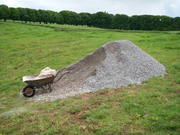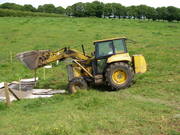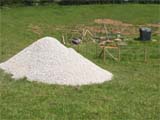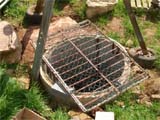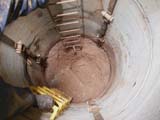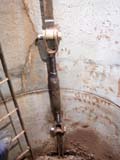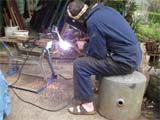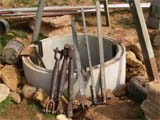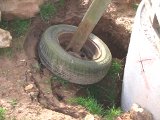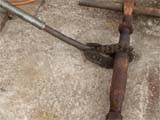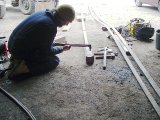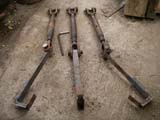At the end of 2008, we realised that the dig was not going to be a straight forward undertaking, but I must admit that I for one greatly underestimated the true scale of the problems.
We had a ten tonne stack of unconnected concrete pipes sitting on soft mud and surrounded by an unstable backfill of soft clay and small rocks. We knew that there was open passage 100+ metres below.
At the beginning, we KNEW that we needed:-
- To stabilise the shaft - lock the segments together.
- To tunnel out from the bottom to find solid rock walls and connect the shaft to these walls
- A LOT of concrete and somewhere dry to store it.
- A power winch and somewhere dry to store it.
- A cement mixer and somehere dry to ... etc etc.
BUT WE DIDN'T KNOW:-
- Quite what to do once the shaft had been stabilised. Had some ideas; mostly idiotic and/or suicidal.
- That we would have so many problems with runny squitty fill.
Ignorance is bliss. Certainly is.
So we did a lot of preparation and then had a halfbaked attempt at digging under the shaft, because we didn't realise that we were not up to it. When we realised our error, we gave up half-baked digging and went back to more preparation for the rest of the year.
Chris Batstone, Jeff Price, Tony Audsley
Took bags of rock from Caine Hill and packed them round the top of the shaft to fill the voids there.
Chris Batstone, Jeff Price, Tony Audsley
Moved the little digging hut towards the centre of the depression to make space for a new digging hut cum engine house. Started laying down a foundation of rock (from Caine Hill) for the new digging hut cum engine-house.
Jeff Price, Paul Brock, Tony Audsley
About this time desperation was beginning to set in as we tried to find a satisfactory method of stabilising the fill at the bottom of the shaft. Ever game for novelty, we tried out silly idea No. 542. This involved blasting a dry mix of 3:1 sand:cement using compressed air. The idea being to fill the gaps in the spoil with sand/cement, which would the absorb moisture and harden. This worked moderately well, but it also filled the shaft with an unbreathable cloud of cement dust. This is not fun and lacking any form of respirator or dust filter, the attempt was abandoned in favour of sloshing in a wet mix, the Willie Stanton method.
No spoil removed.
Alice Audsley, Annie Audsley, Roger Galloway, Tony Audsley
Kibbles: 1
Bags: 2
The depression was dry, although the new blue drain pipes were taking a very small amount of water. There was a small pool at the bottom of the shaft.
Tried drilling into the rock walls, with slightly mixed success. Got three good holes in but when trying to work to the left or the right of these found that solid rock was more that a drill length away. Hauled out two of the bags of fill put down there on 18th July; three more to go. Also hauled out one load of 'proper' spoil.
Ivan Sandford, Jeff Price, Tim Large, Tony Audsley
Some time ago, Tim had bought a 15 ft long, substantial section I beam from a lady in Blagdon and it seemed that we might find a use for it at the dig.
The removal team hauled it out and loaded it onto Ivan's trailer, then drove in convoy to Home Close where it was deposited with the rest of the ironwork at t'hole.
We then retired to Hunters' for well earned tea and biscuits.
Jeff Price, Tim Large, Tony Audsley
Surface preparation work. Dug channels to the drainage sump and filled them with the Belfry gravel. Rain prevented further play, so we retired to Hunters' (Sensible decision).
Tony Audsley
Took 12 bags of stone chippings from the Belfry car-park to t'hole (thank you to Henry Dawson for this). The depression drainage system seems to be working well and the ground around the yellow sump is drying out and beginning to crack.
For those of you who feel tired, jaded and sad, here is an exciting photograph of mud ... drying ... slowly ...
Tony Audsley
A quick visit to check if the drainage system was working after the torrential day of rain on Tuesday. The depression was draining well and a small amount of water was still running down the pipes. By contrast, the adjacent depression had a 16 inch (or 406mm if you insist) deep pool.
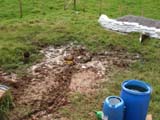 05AUG09: The drained, but still soggy, depression. |
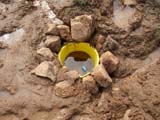 05AUG09: The drainage sump (a yellow plastic bucket). |
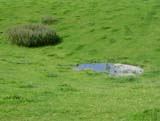 05AUG09: For comparison, the undrained next depression with a 16 inch deep pool at the bottom. |
Alice Audsley, Annie Audsley, Roger Galloway, Tony Audsley
While syphoning did drain the pond, it reformed overnight and we now realised that we had a significant problem with water and we would have to do something about this if we were ever going to get any where with the dig. In other words, it was about time that we made a serious attempt to take control of the fill at the bottom of the shaft and make it more stable. We realised that this was going to take some considerable time.
So, more surface preparation. The intention was twofold; (A) to stop the water from the pool flowing down the outside of the shaft as this was washing away material from around the concrete rings and (B) pipe the surface water to below the level of the bottom ring, which would dry the spoil round this ring. Once less of a slurry the fill would be more amenable to being under-mined.
So, we started by digging a trench at the level of the bottom of the first ring from the shaft towards the centre of the depression. Roger then drilled a couple of 60mm holes through the ring and a couple of 25mm water pipes were run from the bottom of the shaft through the holes and along the trench to a bucket which had been sunk in the slime in the centre of the depression. Much fun was had by all.
More importantly, the pipes seemed very effective at draining the depression. We'll see what happens next time it rains.
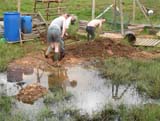 Alice Audsley, Annie Audsley & Roger Galloway digging a trench for the drainage pipes |
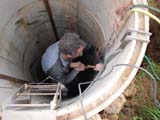 Roger Galloway trimming a hole he has just drilled |
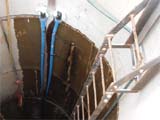 The drainage pipes fitted in the shaft |
Chris Batstone, Stuart Lindsey, Tony Audsley
Bags: -5
Because of the saturated state of the site, we had abandoned the idea of concreting and instead intended to fill the hole that Paul had dug out on Wednesday with some bags of spoil to prevent any risk of a run-in.
Unfortunately, when we got to the bottom of the shaft we saw that the fill had beaten us to it and wiped out Paul's work very neatly. The excavation was no more. Four out of the five rebar supports had held, but mud had sludged between the bars and rocks had moved down from the right-hand (western), unsupported side of the excavation. Not good.
A reverse digging session then started. Five bags of spoil were lowered down the shaft and jammed in, round and under to prevent further collapse. We will have to be more careful next time.
Back on the surface for pies and bread pudding. This was followed by a afternoon session, to see if we could syphon the water out of the pond before trying the more permanent solution of piping the water down the inside of the shaft.
Digging total:- minus 5 bags of spoil removed from the dig.
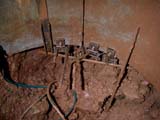 Temporary shoring & run-in at the base of the shaft |
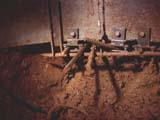 Temporary shoring & run-in - detail |
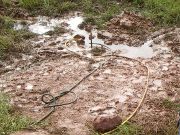 Attempting to syphon the pond |
Tony Audsley
An afternoon of steady, heavy rain. Went over to t'hole, filled the water tanks in preparation for cementing at the weekend and generally fiddled about on the surface while they were filling.
The pond had overflowed the dam of spoil and a respectable stream of water was flowing down the shaft.
The site looks much too wet to attempt concreting at the weekend.
Henry Dawson, Jeff Price, John Noble, Paul Brock, Tony Audsley
Kibbles: 9
Frogs: 1
Digging down below the temporary roof of rebars in preparation for casting the first cement seating for the shaft. Paul did most of the digging and John did most of the hauling. Nine loads, one rock and one frog were hauled up the shaft. Strictly speaking, the frog travelled up the shaft inside John's oversuit; when he got to the surface, it took quite a while to get the frog out as it seemed to have formed a strong emotional attachment to John.
The digging cleared back to the rock wall and produced a void sufficient to cast a 600-700mm cube of concrete.
Later Henry and Tony went down to test the washing system. At first this insisted on producing only a pathetic dribble despite much pipe blowing and sucking by the surface and underground teams. Finally, the joint between the down-pipe and the tap was opened and the tap and the bottom 6 inches of pipe were found to be stuffed with small leaf fragments; a leafcutter bee had made a nest in the hose pipe.
Once this blockage was removed water sprayed everywhere.
Henry was OK, he was part way up the ladder.
Tony Audsley
Fixed up a header tank and connected it to the 'water main' in the shaft. Away from the dig, made up a skip for lowering cement down the shaft.
Tony Audsley
Tony installed a water-pipe down the shaft with a tap at the bottom. The water supply will come from a header tank on the surface. This should be useful when the rock wall needs cleaning up before casting the cement plug against it.
Fitted a guide rope down the shaft for the bucket to (hopefully) prevent it from jamming against the ladder, which it seems to like to do.
Unfortunately the shaft has a small degree of underlie, having shifted slightly because of water washing out the supporting fill. After Hunters', dragged varied bits of scrap metal from the heap at the dairy unit over to t'hole.
Alice Audsley, Tony Audsley
Kibbles: 4.5
Because of the problems experienced with drilling, we came up with a 'Plan B' which was to hammer pointed lengths of rebar through the fill and into the rock wall and support the outer ends with clamps bolted to the concrete rings.
Tony had previously made up three more 'drilling jig clamps' and pointed up some lengths of rebar, so went down t'hole and fitted the jigs to the bottom of the pipes then hammered the pointed bars through the fill and into the wall behind. We hope that just hammering the bars into position will work rather than having to drill a hole for each bar ... time will tell.
[It did and they didn't]
When the bars were in position, we excavated under them and tunnelled towards the wall. Got to touch the rock wall! As too much excitement is bad for the elderly, we packed up at this stage. Nine (smallish) loads of spoil removed; roughly equivalent to 4.5 kibbles worth.
Alice Audsley, Chris Batstone, Tim Large, Tony Audsley
Found that the ladder anchors were firmly set, so bolted the ladder to the wall. This is a great improvement as the ladder no longer flails about at the bottom of the shaft.
The surface party (Alice, Chris, Tim) then bagged some of the aggregate and made a wall of bags round the heap to prevent it from sliding into the pond, which still refuses to drain and largely fills the depression up to the boundary fence.
Tony went down the shaft, clamped a drilling-jig-and-guide to the bottom of the concrete shaft started drilling in the right direction to find the rock wall. This system of jig-and-guide had worked well previously at Fernhill when drilling into a rock wall behind mud fill. However, drilling into the mudstone was a bit problematical, as the relatively soft rock produced small chips which repeatedly jammed the drill in the tube guide.
By the end of the afternoon, a fine retaining wall had been built round the heap of chippings and two deep holes had been drilled into the rock wall - more to follow, but a new drilling technique may be needed.
Jeff Price, Tony Audsley
Jeff brought out his Hilti drill and a pukka Hilti resin kit and resined some anchors in position for the ladder.
Alice Audsley, Pete Page, Tony Audsley
Alice and Tony laid some sheets of wriggly tin as a foundation for the gravel heap, to prevent the gravel from sinking into the mire. They then started to shovel and barrow the aggregate into the depression. A pathetically small amount was shifted in this way then Pete Page turned up with his shovel and he shifted the rest in less than 20 minutes - thanks.
Tony Audsley
Took delivery of 10 tons of aggregate. The driver kindly backed just to the edge of the depression before tipping the load which was a great help. I then filled a 220 litre container with water by syphoning it from the nearby drinking trough. This was in preparation for cementing works at the bottom of the shaft.
Tony Audsley
In summary, most work involved accumulating useful materials and trying to get non-functional power winches and generators into some sort of working order (with a marked lack of success). At the dig, the old gate from Fernhill cave was fitted to the top of the shaft.
Jeff Price, Tony Audsley
Took generator and drill, cables etc over to the hole. We found that the resin used to fix the ladder bolts to the pipes had not hardened. Either it had not mixed properly, or more likely, too old. Jeff will get some new resin. Tony used the drill jig and 1 metre drill bit to drill into the rock under what he thought was the north wall of the shaft; only to find that all four holes attempted went to full depth without hitting much that was solid. Much confusion as the rock wall of the rift was known to be less than two feet away.
After much scratching of head and looking at it from the top and the bottom of the shaft, it appears that he had been trying to drill ALONG the rift rather than into the wall, ie east instead of north, 90° out. Never mind, better luck next time.
Jeff Price, Tim Large, Tony Audsley
Kibbles: 1.5
Fitted small brackets to the bottom of the two ladder standoffs, then drilled 8mm holes (about 2 inches deep) in the concrete pipes, filled with resin and inserted stainless studding to anchor the ladder. This left to harden until next visit before bolting together.
Probed under the north wall to try to find the 'solid' rock wall of the rift which is behind there somewhere. Either we didn't find it or it is not very solid; more work required. Then used Jeff's 36 volt Hilti to drill about 14 holes in a line across the boulder in the floor and used a gad (spike) in the holes to split the rock in two. Removed 1½ skip loads, mostly shattered rock.
Alice Audsley, Tony Audsley
Alice and Tony went over to the dig and took some photographs of the bottom of the shaft, detailing the jacks and strapping.
Duncan Butler, Jeff Price, Tim Large, Tony Audsley
Kibbles: 15
Tony fitted the now newly freed bottle-jack, then dug out 9 skip loads. Duncan then came down and dug out a further 6. There is a large(ish) boulder appearing at the bottom of the shaft which will have to be removed before too long.
Jeff Price, Tim Large, Tony Audsley
Kibbles: 10
Excavating at the bottom of the shaft for fitting the straps. Fitted the second strap and jack and fixed the third strap into position, but then found that the third jack was jammed solid, so couldn't tighten and fit it. Ten skip loads removed. Took the jammed jack away for fettling.
Jeff Price, Tim Large, Tony Audsley
Kibbles: 10
Excavated at the base of the shaft to try to fit the bottom straps and jacks. Managed to fit one. Ten skip loads removed.
Alice Audsley, Tony Audsley
A day largely of surface work; started at home, welding on strips to reinforce the bottom hooks. Then took all back to Wigmore and tried the jacks and lower straps in position in the shaft, measuring up for the bottom loops. Then to Nigel's workshop with the marked-up bottom straps and used some more of his gas (many thanks) to heat and form the loops for the bottom straps.
Tony Audsley
Continued working in Nigel's workshop. Reinforced the top hooks by welding on strips to form a channel section. Ground down the loops to fit the top of the jacks, then towed the top straps back to the dig and lowered them down the shaft and fitted roughly into position.
Tony Audsley
Towed the three 10 metre steel straps from the shaft to Nigel Perkins' workshop. Then used his gas set to heat and bend the straps to form hooks to fit over the ends of the shaft and loops to connect to the jacks.
Tony Audsley
- 2009.012: Tue, 31st Mar: More work on the jacks - all day.
- 2009.011: Sun, 29th Mar: All day working on freeing the screw jacks.
- 2009.010: Sat, 28th Mar: Working in Nigel Perkins' workshop bending the ends of the short (bottom) straps to fit the shaft and the jacks.
- 2009.008: Fri, 20th Mar: All day on the bottle jacks.
- 2009.007: Thu, 19th Mar: All day working on the bottle jacks.
- 2009.006: Sun, 15th Mar: Visited and found voids at the side of the shaft where the fill had been washed out. Backfilled these with the stone from Caine Hill. Took lengths of re-bar (which had been left at the Farm House by Avon Steel) over to the dig.
- 2009.005: Sat, 7th Mar: Working at home, freeing rusted 5 ton bottle jacks obtained from the Belfry.
- 2009.004: Mon, 23rd Feb: Took a few more Caine Hill bags of stone over to the shaft.
- 2009.001: Sun, 25th Jan: Took a few bags of stone from Caine Hill over to the shaft.
2009 started still with no solution to the problem of holding the shaft rings together. Steel strapping (50 x 6 mm flat) had been at the dig since October 2008, but no easy way of using this to tension the column had presented itself. Some 5 tonne screw-jacks had been noted half buried behind the Belfry, but they were rusted solid and as the threads were 3½ in diameter (38mm), I had discounted them thinking that they might be impossible to free.
However, there was nothing else available; so a combination of bloody-mindedness, a chain-wrench with a 6ft waterpipe extension on the handle, a LOT of heat and a tiny bit of oil meant that they gave way, a bit at a time. The most resistant took 12 hours, spread over two days, before both threads were free.
 |
 |
Created: 05-May-2010
Revised:

